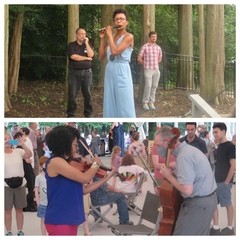|
Back
John Luther Adams’ Avian Adventure New York
Katonah (Caramoor Center for Music and the Arts, Venetian Theater)
07/11/2021 -
John Luther Adams: ten thousand birds
Alarm Will Sound: Erin Lesser (Flute), Allison Loggins-Hull (Flute and Celesta), Christa Robinson (Oboe), Bill Kalinkos, Elisabeth Stimpert (Clarinets), Nanci Belmont (Bassoon), Laura Weiner (Horn), Tim Leopold (Trompet), Chris Thompson, Matt Smallcomb, Eric Poland (Percussion), John Orfe (Piano and Celesta), Courtney Orlando, Monica Davis (Violins), Ashleigh Gordon (Viola), Miles Brown (Bass), Alan Pierson (Artistic Director)

J. L. Adams/Bird-Score (© Courtesy of the Artist)
“By shallow rivers, to whose falls/Melodious birds sing madrigals.”
Christopher Marlowe (1564-1593), The Passionate Shepherd to his Love
“My life’s work began with birds.”
John Luther Adams (1953– )
ten thousand birds doesn’t start in a cage...or an aviary…or even the well-structured movements of John Luther Adams’ 40-year-old Songbirdssong. In the Venetian Theater tent of Caramoor yesterday afternoon, ten thousand birds fluttered and beeped and twitted and whispered and murmured and almost literally took flight around the 4,000-plus square-foot area.
The sounds-which were never heard before and never will be heard again–were in counterpoint with over 400 people: children from six to 90 swaying, dancing, playing hide-and-seek with the artists. Some of the audience did yoga in the outside trees, others swayed and moved with the solos, duets, quodlibets and canons of the musicians.
For over an hour, Caramoor presented (for lack of a better word) an acoustic celebration of birds, written with the singular pen of Mr. Adams.
John Luther Adams was hardly the first to simulate birds. In fact, it would be more difficult to find composers not using what Messiaen called “the greatest musicians to inhabit our planet.” Rameau, Beethoven, Janequin, Mozart, Respighi, Stravinsky, Dvorák: the list goes on indefinitely. But Adams, who enjoys the solitary avian life of his home in Alaska, had–as anyone who knows his music–a freer hand.
His music encompasses oceans and deserts. Buddhist meditations and the silences of the Arctic. For all of these, we in the audience had sat and listened, mulled and (sometimes) meditated. For Mr. Adams’ genius is not music as such, but music to transport us to a universe next door.
ten thousand birds, though, was different. We weren’t supposed to sit. We were supposed to perambulate. Caramoor’s original perambulations were supposed to be through the ravishing endless foliage of the gardens themselves. Alas, the Gods of Rain, predicted downpours which never came. So the venue was changed to the Venetian Theater, actually a tent from which one could wander into the neighboring trees.
We had no instructions, but the splendid artists of Alarm Will Sound and Artistic Direction of Alan Pierson created an atmosphere where wandering was imperative. Since prior to watching the musicians we heard them. On one side would be flute and horn, suddenly from the corner came violist bowing and cellist plucking. A trumpet honked at a group of children, a string trio danced across another stage, a violin played solos on the stage, with a bass drum at the other end of the tent.

E. Lesser/A. Gordon, L. Stromberg (© Samuel A. Dog)
Alarm Will Sound has the finest young musicians in New York, but none of then has shirked at movements and moves to consort their own particular consorts. So here John Luther Adams had created an aura of flight, murmurations and even nesting.
How many birds were among the Ten Thousand? The musicians I asked didn’t know, but surmised perhaps 40, or 50 or 60. After all, most of the sounds were not individual, like Adams’ Songbirdsong, but in duets or trios flying through the tent. Yet–and this was essential–Adams, like Messiaen and Respighi–had created individual calls for every one of the birds, written themes (leitmotifs?) for each species.
Yet who has ever gone through a forest to hear a single birdsong? That “birds-of-a-feather” stuff is hardly true. Adams made certain that the calls were in aleatory counterpoint with the others. In other words, within the diurnal/nocturnal perimeters, each musician could blow, pluck, bow, twang, blow or strike as the instinct came. Simultaneously or sequentially. And if this huge tent wasn’t quite a forest or not exactly the manicured lawns of Caramoor , it was the next best thing.
Initiates know instinctively that a work by John Luther Adams can never be part of a concert per se. For the most part (not always), it is an intensely moving experience. Here the movement was quadrupled. The movement of the audience, the unexpected movement of the music, the movement of Caramoor’s trees, and the movement of these splendid musicians, transformed, as mythologies know, into disembodied and eternal souls.
Harry Rolnick
|